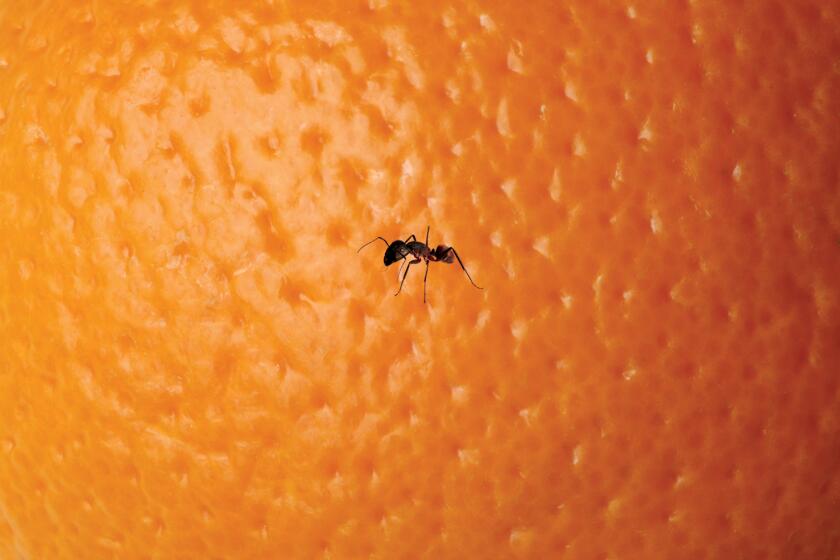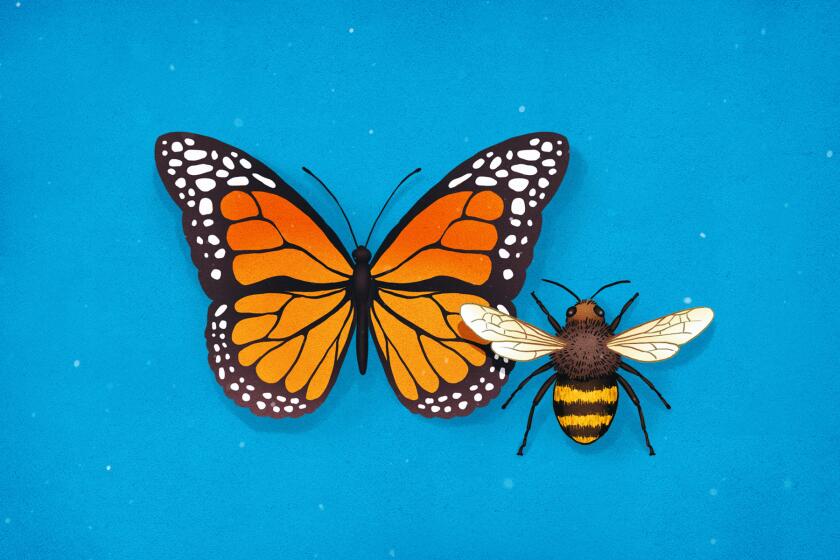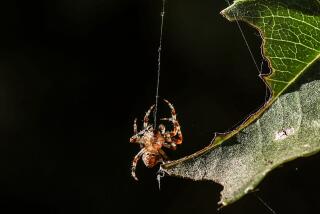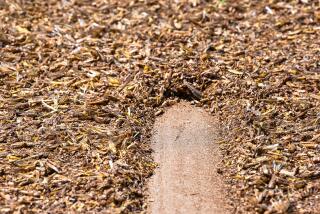Your spring garden is candy to pests. Stop them before they start munching

- Share via
It’s been a great spring for gardening, and your new plants are growing like gangbusters. But then it gets hot and dry. You stop visiting your veggies every day; maybe a whole week passes. And then one evening you take a garden stroll, expecting the same lush, green growth, and what you find is ... horror!
Your kale is covered in what looks like a writhing armor. Healthy seedlings have been reduced to stubs. Tiny webbing is mottling your eggplants, your cucumber vines have withered and whole branches of your tomatoes are shockingly bare.
OMG! What is going on?
Welcome to the dark side of gardening: the sap-sucking, leaf-chomping pests.
Luscious new growth is candy to pests like aphids, whiteflies, hornworms and snails, and hot, dry summers are the welcome sign for spider mites and squash bugs, who literally suck the life blood out of your plants.
Truth be told, if you have infestations as bad as the descriptions above, your best bet is to pull up your affected plants and start again, said Yvonne Savio, creator of the Gardening in LA blog and former head of Los Angeles County’s Cooperative Extension master gardener program.
You’ll have to declare brutal warfare on the ants in your yard while embracing a tiny parasitoid wasp that eats its living prey from the inside out.
But it doesn’t have to get so bad. The trick is prevention and daily monitoring, said Savio and Cheryl Wilen, area advisor for the UC Cooperative Extension’s Integrated Pest Management Program.
The IPM approach uses a variety of tactics for managing pests rather than the nuclear option of dousing everything in pesticides, which kills good bugs along with the bad, Wilen said. “Good” bugs like parasitic wasps, ladybugs and lacewings, are essential allies in destroying the critters who want to devour your plants.
Savio has a garden outside her Pasadena home, but she rarely has pest problems, she said, because her first priority is keeping her plants healthy, with a soil full of compost and other organic amendments, consistent deep watering a few times a week and a thick layer of mulch to help keep the roots cool and moist.
Too much fertilizer can make plants vulnerable too, Savio said, especially if it’s heavy in nitrogen, which is especially attractive to sap-suckers. It’s better, she said, to build a soil full of nutrients than try to make up for deficiencies with fertilizer.
Just as important are regular visits to the garden, so you can find problems before they become insurmountable.
“You’ve got to go out and look at your plants every day,” Wilen said. “Turn over the leaves to look for eggs or look at the buds ... is somebody eating them? It’s really fun to do, and it’s how you get to know your plants. Plus, if you see your plants are wilting, you might discover a broken irrigation line before you lose your entire crop.”
What plants will fill your yard with happy bees and butterflies? These six species are musts.
If Savio finds a few aphids on her plants, for instance, her first line of defense is to wash the bugs away with a strong stream of water. But you have to look carefully, under the leaves, she said, where the bugs tend to hide, and your water pressure has to be strong because sap-suckers attach themselves to the plant to eat, so they don’t easily wash away,
Wilen prefers the spot-and-squish method with early infestations, “because by the time you pull out the hose, and turn the leaves over, it’s just as easy to squash them between your fingers.”
Best to wear gloves, however. Natural pest eradication is not for the squeamish.
Here’s a breakdown:
The good
The first lesson is learning how to share your garden with beneficial and benign bugs. Savvy growers lace their gardens with fragrant flowering plants like African blue basil, nasturtiums and cosmos to draw honeybees and other pollinators to their edible plants. Ladybugs and lacewings devour aphids, and wasps dine on the caterpillars that love to chomp your tender plants.
The (maybe) bad
Many people worry about bugs that are relatively harmless in the garden, such as pill bugs, a.k.a. roly poly bugs, which roll themselves into balls like tiny armadillos, and earwigs, with their revolting rear-end pinchers. Wilen said. Both bugs primarily feed on decaying plant material, but if you get too big an infestation, especially of earwigs, they can start eating live plants, and honestly, is there anything more disgusting than a huge nest of earwigs?
The best remedy for earwigs is to trap them when they are active at night, Wilen said. Leave a damp rolled-up newspaper in the problem area and then check it in the morning. You will likely find plenty of earwigs that crawled inside to hide during the day. Be prepared to either stomp the earwigs once you shake out the paper or submerge the whole paper in a bucket of water to drown them. Another option is creating a pitfall trap by burying an empty tuna can (or any similarly shallow can with straight sides) so its top is level with the ground. Then fill the can partway with vegetable oil and a little soy sauce or molasses. The earwigs, and other bugs, will crawl in and drown because they can’t crawl out, Wilen said. Remove the bodies daily (remember, stiff upper lip) and replenish the attractant as needed.
It’s time to stop wringing your hands over COVID-19: Plant some food and create your own victory garden. Here are eight steps to get started.
The ugly
This list, alas, is fairly long. Wilen recommends visiting the Integrated Pest Management Program’s website for more detailed information and helpful videos about a variety of garden troublemakers, but here are her recommendations for dealing with six of the most common pests:
1. Ants
On their own, ants don’t do much damage to garden plants, but if you see lots of ants crawling around your garden, chances are they are encouraging aphids, whiteflies and other sap-sucking insects that excrete a sweet substance called honeydew. Ants tend sap suckers the way shepherds tend their sheep, protecting them from predators. If you want to get rid of the sap-suckers you need to tame the ants first, with sugary boric-acid baits that are nontoxic to people and pets (unless you eat large quantities) but will slowly poison the entire ant colony. It’s important to use a bait that is slow-acting, Wilen said, so the workers can carry it back to the nest and feed it to the queen and the rest of the colony. One recipe calls for using 1 cup of sugar, 3 cups of water and about 1 teaspoon of high-purity (99%) water-soluble boric acid and putting it in a refillable container, such as the KM AntPro Liquid Ant Bait dispenser. If in doubt, use less boric acid instead of more, to make sure the poison is dispersed throughout the entire colony. Another option is an ant bait gel with .01% thiamethoxam, such as Optigard.
2. Aphids
It wouldn’t be spring without aphids, but if left to their devices they can cover a plant and suck it dry. Here is where it helps to encourage ladybugs and lacewings, two insects that find aphids particularly yummy. Be careful about buying ladybugs and releasing them in your yard, however, since there is no guarantee they’ll stick around unless they find plenty of food (i.e. aphids). Here’s where daily monitoring pays off: Check the back side of leaves, and when you see an aphid, squish it or wash it off with a strong blast of water. Savio recommends a spray consisting of 1 tablespoon each of Tabasco sauce and dish soap mixed with 1 quart of rubbing alcohol and 1 gallon of water. Planting sweet alyssum will attract parasitic wasps, which are natural enemies of sap-sucking insects.
3. Hornworms
Every tomato grower has a horrible hornworm story. These giant green caterpillars are fascinating and revolting, but, boy, can they eat, stripping whole branches of their leaves and munching on your tomatoes. Hornworms do most of their eating at night and are the same color as tomato leaves, making them difficult to spot. They tend to hide under the leaves during the day, so your best option is to search for their tiny piles of black poop, called frass. If you spot the frass — which is about the size of a sesame seed, Savio said — search the leaves directly above for the hornworms. Another trick is to spray the plant with water, Savio said, “which makes them start wiggling and easier to spot.” Pick them off the plant and drown them, clip them in half with your clippers or stomp them, as you prefer. (Note: If you choose the stomp method, wear closed-toe shoes because they tend to squirt.)
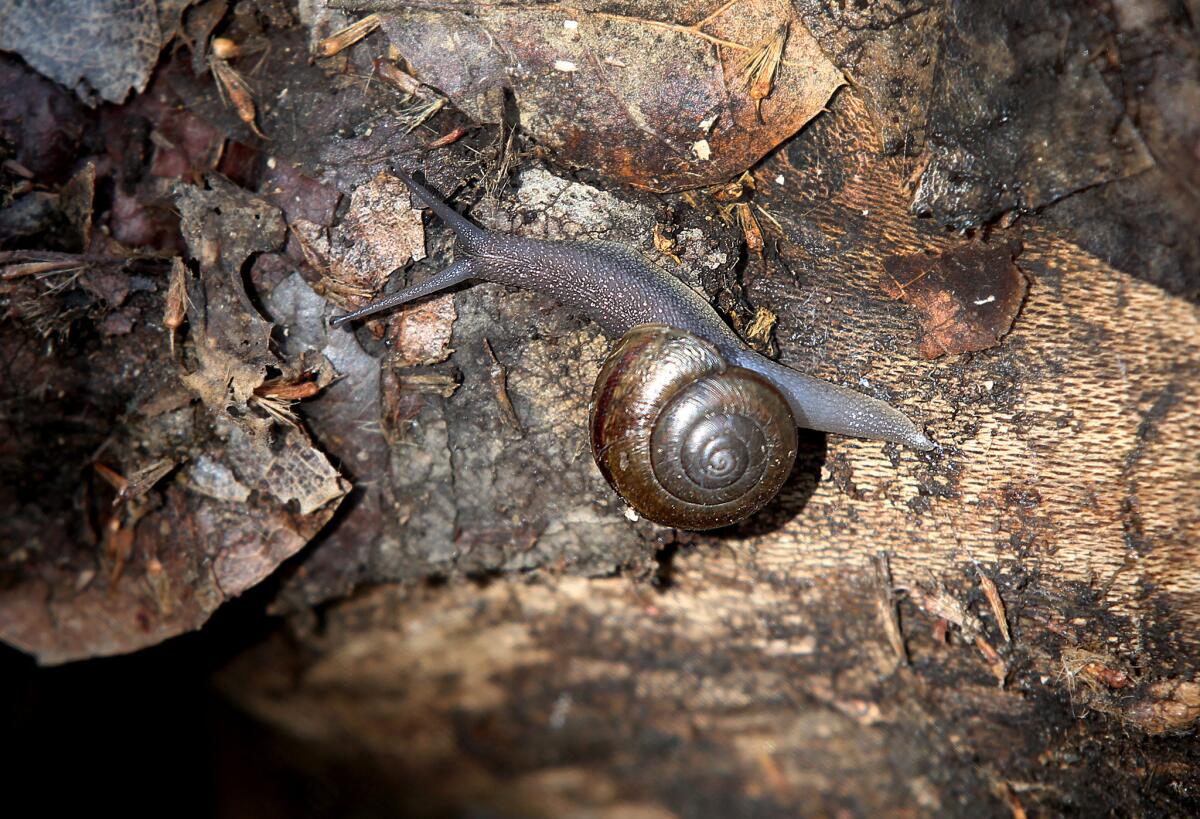
4. Snails and slugs
These slimy land mollusks may move slowly but they can devour a crop of tender seedlings overnight, leaving only the stems and a shiny, telltale trail behind. By day, slugs and snails hide under leaves, rocks or boards and do their damage at night. The most effective control is to search and stomp at night, when they venture forth; put out boards for them to hide under, so you can easily find and destroy them in the morning; or use a pitfall trap filled with a few inches of beer. Like many creatures of the night, snails are partial to beer, but they aren’t snobs. Savio said her colleagues at UC Cooperative Extension did an extensive test and found Coors Light was their brew of choice. Snails and slugs are attracted by the smell, so you need a straight-sided container deep enough for them to fall in and drown. Ladle their bodies out in the morning.
5. Spider mites
If your garden plants have mottled leaves and lots of fine webs, chances are you have spider mites. Most mites are too small to see without magnification, but if you’ve fallen behind in your watering, and it’s been hot, dusty and dry, those are the perfect conditions for these pernicious sap-suckers. Usually by the time you notice the infestation, it’s too late to save the plant, said Savio, who recommends pulling up the infected plant, wrapping it in a plastic bag and throwing it away before you replant. The best defense here is prevention, said Savio and Wilen. Give your plants consistent deep watering, especially when it gets hot, and periodically sprinkle the area to keep down the dust and discourage the mites, who prefer things dry.
6. Whiteflies
These aren’t true flies but tiny sap-suckers with wings that, like aphids, excrete a honeydew that makes them appealing to ants. Heavy infestations are hard to manage. Whiteflies hang out on the undersides of leaves, so search carefully and remove infested leaves or spray them down with water to dislodge the pests. Neem oil, a natural, plant-based pesticide, can also help, but prevention is the best option. Encourage their natural predators, such as lacewings, discourage the ants that protect them and trash (not compost) heavily infected plants so the insects can’t overwinter and return next year.
More to Read
Sign up for The Wild
We’ll help you find the best places to hike, bike and run, as well as the perfect silent spots for meditation and yoga.
You may occasionally receive promotional content from the Los Angeles Times.
